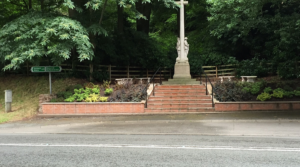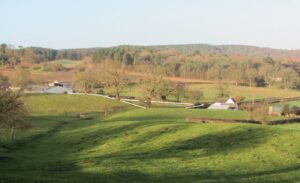HISTORY
The Parish of Maer & Aston is rural with scattered residential development and devoted to farming together with a large area of commercial forestry in Maer Hills. This was formerly heath land and was enclosed in 1810 for its present use. A number of strenuous and long campaigns have been fought by local people from the 1970s onwards to prevent this forestry area from becoming a gravel pit, a succession of golf courses, a massive residential development and holiday leisure site and wind farm.
Records show that Maer village is the oldest settlement, having been populated from Saxon times and being held successively as a large estate by Normans, the de Mere family, the Macclesfields, Talbots, Wedgwoods, Davenports and Harrisons until the break up and sale in the early 1970s. In consequence it has been spared from the ravages of the post war building boom. Its present designation as a conservation area hopefully ensures similar protection in the future. The main features which led to this designation are the Hall and grounds, the setting of the church on high ground opposite, together with the bridge from the Hall to the church. Many of the existing houses have retained their estate character including the Home Farm and the Old Laundry. Such infill that has taken place has not been sufficient to destroy this attractive village character.

The most famous occupants of the Hall were the Wedgwoods; Josiah Wedgwood II, the son of the famous potter, moved to Maer in 1807. He went back to Etruria for a short while, returning and settling in Maer until his death in 1843. During this period Charles Darwin, a nephew of Josiah II was a frequent visitor to the Hall. He subsequently married Emma Wedgwood, Josiah’s daughter on his return from his epic voyage on the Beagle. Charles and Emma were married at Maer Church and copies of their marriage registration are in the Church. Darwin himself wrote, “my visits to Maer during these years were quite delightful, independent of the Autumnal shooting.” The village in those years was the centre for the local hunt.

The Harrison family were involved in shipping, with strong connections with Liverpool and The White Star Line. Following World War I, the war memorial was sited on a small plot of land off the A51 opposite the end of the road that leads out of the village. The Harrisons also endowed a cottage for use by the Girl Guides which has always been very popular.
In previous years most of the inhabitants were employed on the estate or in neighbouring farms. Today with the revolution in agriculture, virtually all the inhabitants in the Parish commute to the nearby Newcastle/Potteries conurbation or work from home. Casual workers come in from outside the area to work on the fruit farm and sporadically to work in the forestry area.
Both Maer and Aston have lost their post offices and shops and have never been allowed to have a public house nearer than the road junction at Blackbrook. The Harrisons were strict tee-totallers and any worker who was found intoxicated was promptly given notice. Mr Harrison would invariably do his best to find alternative employment for the unfortunate worker however one poor sole was cheerfully told he had new employment waiting for him on an ocean going liner only for that ship to be The Titanic. Mr Harrison was reportedly most disturbed that the poor man perished in the disaster!
The Harrisons were for responsible building the first school in Maer has now become the Village Hall. A subsequent school on the A51 closed during th e 1970s, the pupils being transferred to Baldwins Gate. The old school building is now a thriving business, mostly internet based, selling clothing etc.
e 1970s, the pupils being transferred to Baldwins Gate. The old school building is now a thriving business, mostly internet based, selling clothing etc.
The village of Aston is in the Ecclesiastical Parish of Woore and residents often travel to Woore for services and facilities, however there is a small chapel within the village hall which is used for occasional services and on one occasion a wedding.
In Aston the original Victorian village school was replaced post-war by a new building which was closed in 1981 and, although the original building was used as a joinery business for a time and a youth club, both have now been converted for residential use.
Aston does have a village hall where community activities take place. Colonel Clive built the village hall in 1955, in memory of his wife Dorothy. Today the village hall is run as a trust and a committee has been formed by members of the village.
Although the original building was burnt down during the Cromwellian uprising, Lea Head Manor is one of the oldest buildings in Aston. One family, the Bucknells owned the building for over 400 years. The current owners of Lea Head Manor are now excavating the original moat.
Midway between the villages of Maer and Aston, along the A51, is located the Dorothy Clive Garden at Willoughbridge. This former gravel quarry was converted to a garden by Colonel Clive for the enjoyment of his invalid wife. It has since been taken over and improved by local trustees to become a well-known and important venue for garden-lovers. This area is also known as Willoughbridge Wells. This first became popular in the 17th Century as a healing centre on account of the numerous springs in the area. They were enclosed and protected for drinking and bathing, said to be “as near a panacea as any medicine in the world.”